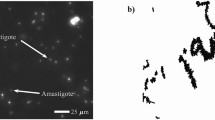Abstract
THE swimming motions of the cercaria of Schistosoma mansoni have been analysed by high-speed photography, at a rate of 500–800 pictures/sec. When cercariae swim backwards the two branches of the forked tail are spread out (Fig. 1a and b), while in forward-swimming cercariae the branches are close together (Fig. 1c and d). Without significantly altering the stroke rate of the tail, cercariae can change from backward swimming to forward swimming, or the reverse, depending on how they align the branches of the tail. When changing from backward swimming to forward swimming the cercaria lengthens its body by 30–40 per cent (Fig. 1c and d) and at the same time makes itself narrower.
This is a preview of subscription content, access via your institution
Access options
Subscribe to this journal
Receive 51 print issues and online access
$199.00 per year
only $3.90 per issue
Buy this article
- Purchase on Springer Link
- Instant access to full article PDF
Prices may be subject to local taxes which are calculated during checkout
Similar content being viewed by others
Author information
Authors and Affiliations
Rights and permissions
About this article
Cite this article
GRAEFE, G., HOHORST, W. & DRÄGER, H. Forked Tail of the Cercaria of Schistosoma mansoni—a Rowing Device. Nature 215, 207–208 (1967). https://doi.org/10.1038/215207a0
Received:
Revised:
Issue Date:
DOI: https://doi.org/10.1038/215207a0
This article is cited by
-
Smooth muscle-like Ca2+-regulation of actin–myosin interaction in adult jellyfish striated muscle
Scientific Reports (2018)
-
Schistosoma mansoni cercariae swim efficiently by exploiting an elastohydrodynamic coupling
Nature Physics (2017)
-
Swimming behaviour of Schistosoma mansoni cercariae: responses to irradiance changes and skin attractants
Parasitology Research (2008)
-
Die Anheftung (Fixation) der Cercarie von Schistosoma mansoni
Zeitschrift f�r Parasitenkunde (1976)
Comments
By submitting a comment you agree to abide by our Terms and Community Guidelines. If you find something abusive or that does not comply with our terms or guidelines please flag it as inappropriate.



